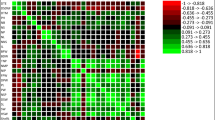Summary
Genotype-environment interactions for green fodder yield in yellow sweet clover (Melilotus parviflora Desf.), by growing 10 genotypes in four different years, revealed that the genotypes interacted significantly with the environments and a large portion of these interactions was accounted for by the linear function of the environmental means. No association existed between the mean values and both the parameters of stability (b and S 2d ). High yielding genotype HFYS 3 was found to be stable for favourable environments, whereas genotype HFYS 7 was more suitable for poor environmental conditions. Genotypes HFYS 8, 10 and 11 were found to be highly stable, whereas the genotypes HFYS 3, 7, 24, 25 and 44 were medium in their stability. Check variety FOS 1 and the genotype HFYS 43 were highly unstable.
Prediction of the mean performance was made using two methods, one by using all the genotypes studied in a set of environments and the other by using only one stable genotype. It was possible to predict the mean performance of most of the genotypes within the limits of sampling error. Use of only one stable genotype for the purpose of prediction was found to be quite useful. The importance of studies on genotype-environment interactions in future breeding programme has also been discussed.
Similar content being viewed by others
References
Breese, E. L., 1969. The measurement and significance of genotype-environment interactions in grasses. Heredity 24: 27–44.
Bucio-Alanis, L., 1966. Environmental and genotypes-environmental components of variability. I. Inbred lines. Heredity 21: 387–397.
Bucio-Alanis, L. & J. Hill, 1966. Environmental and genotype-environmental components of variability. II. Heterozygotes. Heredity 21: 399–405.
Bucio-Alanis, L., Jean. M.Perkins, & J. L. Jinks, 1969. Environmental and genotype-environmental components of variability. V. Segregating generations. Heredity 24: 115–127.
Eberhart, S. A. & W. A. Russell, 1966. Stability parameters for comparing varieties. Crop Sci. 6: 36–40.
Finlay, K. W. & G. N. Wilkinson, 1963. The analysis of adaptation in a plant breeding programme. Aust. J. agric. Res. 14: 742–754.
Jinks, J. L. & J. M.Stevens, 1959. The components of variations among family means in diallel crosses. Genetics 44: 297–308.
Malik, J. S., R. S. Paroda & N. D. Arora, 1973. Genotype-environment interactions for green fodder yeild in cowpeas. Z. PflZücht. 69: 333–339.
Mather, K. & R. M. Jones, 1958. Interaction of environment in continuous variation. I. Description Biometrics 14: 343–359.
Paroda, R. S. & J. D. Hayes, 1971. An investigation of genotype-environment interactions for rate of ear emergence in spring barley. Heredity 26: 157–175.
Parora, R. S., R. R. Karwasra, & H. R. Yadav, 1973. Prediction of phenotypic performance through genotype-environment interaction studies in fodder cowpeas (Vigna sinensis Endl.). (Paper presented at the second general congress of SABRAO.) Indian J. Genet. (in press).
Paroda, R. S., D. V. S. Panwar, & G. D. Sharma, 1973. Genotype-environment interactions for green fodder yield in sorghum. Indian J. agric. Sci. 43: 386–388.
Paroda, R. S. & K. R. Solanki, 1973. Implications of studies on genotype-environment interactions in forage crops. Proc. of Seminar on ‘Recent trends in Biological Sciences’ (in press).
Parora, R. S., K. R. Solanki, & B. S. Chaudhary, 1973. Phenotypic stability in oats. Indian J. Genet. 33: 92–95.
PerkinsJean. M. & J. S. Jinks, 1968a. Environmental and genotype-environmental components of variability. III. Multiple lines and crosses. Heredity 23: 339–356.
PerkinsJean. M. & J. L. Jinks, 1968b. Environmental and genotype-environmental components of variability IV. Non-linear interactions for multiple inbred lines. Heredity 23: 525–535.
Samuel, C. J. A., J. Hill, E. L. Breese, & A.Davies, 1970. Assessing and predicting environmental response in Lolium perenne. J. agric. Sci., Camb. 75: 1–9.
Yates, F. & W. G. Cochran, 1938. The analysis of groups of experiments. J. agric. Sci., Camb. 28: 556–580.
Author information
Authors and Affiliations
Rights and permissions
About this article
Cite this article
Karwasra, R.R., Yadav, H.R. & Paroda, R.S. Prediction of phenotypic performance through genotype-environment interaction studies in yellow sweet clover (Melilotus parviflora Desf.). Euphytica 24, 261–267 (1975). https://doi.org/10.1007/BF00147196
Received:
Issue Date:
DOI: https://doi.org/10.1007/BF00147196




